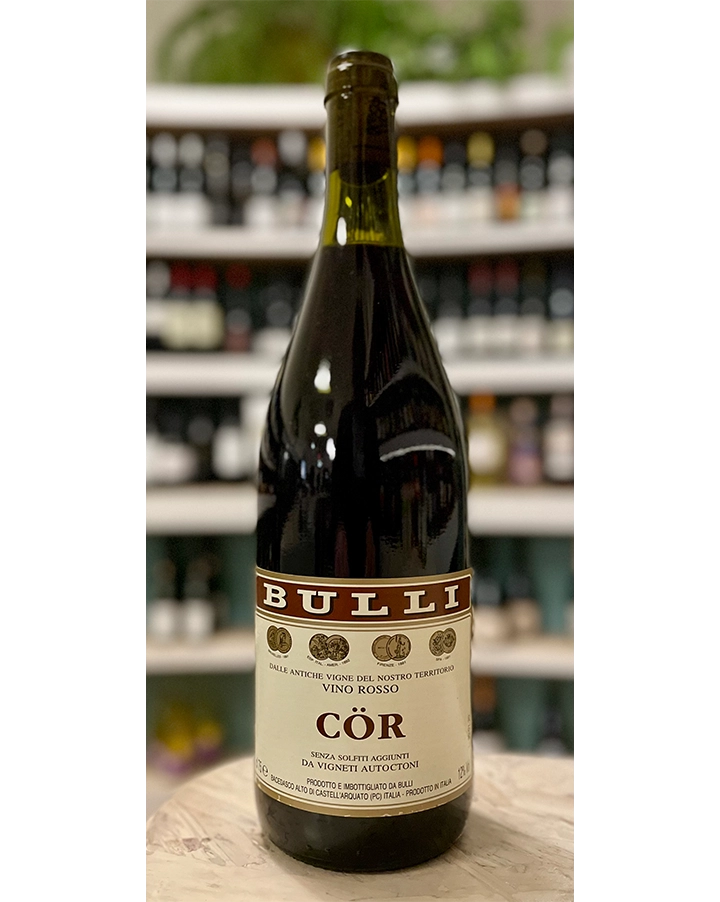Bulli "Cör" NV Rosso di Colli Piacentini Emilia Romagna
Bulli "Cör" NV Rosso di Colli Piacentini Emilia Romagna
REGION: Emilia-Romagna
GROWING AREA: Colli Piacentini
FARMING: Practicing organic
VINEYARD: 4 Ha. Torrano, San Giorgio e Ponte dell’Olio, Sbarrata, Colle San Giuseppe
ALTITUDE: 400 m / 1,312 ft SOILS: Limestone and mildly alkaline soils, specifically the soils called San Faustino, Montemaggiore, and Gorgognano
VARIETIES: 40% Barbera, 30% Malvasia di Candia, 20% Bonarda (Croatina), 10% Uva Rara
VINE AGE: From 10 to 50 years old
VINE TRAINING: Guyot
HARVEST DATE: From September 20 to October 20
YEASTS: Native
FERMENTATION: 10 to 15 days on the skins with periodic racking (Bonarda/Croatina can be reductive), in cement tanks
MALOLACTIC FERMENTATION: Yes
SULPHUR: No SO2 added
ALCOHOL: 12%
ANNUAL PRODUCTION: 1,000 cases
From organic vineyards in the hills around Piacenza in western Emilia-Romagna, made by the Bulli family with no sulfur or anything else added. On the lighter side of medium bodied with crunchy red and purple berry fruit and wild herbs. Serve with a little chill next to cured meat and salty cheese or something grilled.
WHY BE CURIOUS: Traditional Emilia-Romagna producer of spontaneous fermentation metodo ancestrale farmer fizz; no added SO2; limestone rich soils. Practicing organic.
WHO: Leonardo Bulli (matriarch-boss is his mother La Signora Bulli).
WHERE: 12 hectares in the Colli Piacentini, the hills around the town of Piacenza
GRAPES: Barbera, Bonarda, Uva Rara; spunky white Ortrugo, and the semi-aromatic Uva Sampagnina (AKA Marsanne).
WHAT WINES TASTE LIKE: limestone and alkaline soils give direct and honest wines, with a rustic minerality and saltiness. As Italians say of an honest farmer wine: Semplice ma non banale. / Simple but not boring.
FUN FACT: Locals line up everyday for his fizzy metodo ancestrale that’s cheekily called ‘Sampagnino’ [ sham-pah-KNEE-know] in a mock-pronunciation of Champagne. La Signora Bulli says she drinks it in a gulp.
Bulli is our newest little gem from the northwest corner of Emilia-Romagna in the Colli Piacentini, those step hills, just south of Piacenza, squeezed between the Po river to the north and the Apennine mountains to the south. The area itself is sleepy, a time-capsule from the 1940’s, with farmers that still have that askance look of their forefathers, those ex-Roman soldiers who tended vines in retirement.
There’s a long tradition of making frizzante metodo ancestrale; in this area, and Bulli has been doing it for five generations, since the late 1800’s. Don’t get the idea that this is a family with a castle. The Bulli family is humble, easygoing, happy to serve locals everyday from their repurposed horse stall, where all the sparkling in the bottle fermentation happens. La Signora Bulli is especially proud of the medallion coins the family has won for its wines in the late 1800’s. They are a testament of it being a serious winery from the beginning. Her son, Leonardo Bulli, is especially proud of the fact that they never used SO2, in fact, senza solfiti aggiunti is written on their original vintage-kitsch style labels since the 1950’s. There’s no faux-retro going on here.
One key that helps preserve their wines without SO2, and gives them a sprightly character, is the soil. Bacedasco Alto is the town where the Bulli family has their house and horse-cellar, and it is right next to an important geological park that contains a series of ancient limestone calanques from the Pliocene period. Think of the calanques near the wine town of Cassis (without the sea ; ).
Between the amazing homemade salumi and gulping down some Bulli fizz with the family on my last visit there, I couldn’t quite understand a sentence in my notes: “La Signora Bulli says that they are famous for whales.” I mean that must be important, right!? It took me a few hours of digging around to figure out the area is famous for finding a large amount of whale fossils. The local museum has a great map of the geological park, and a cool video of the unearthing of a whale fossil in 1936.**
These are the kind of wines we are proud to import: a rich history, complex soils, hand-crafted and natural wines, good people – and a whale bone connection.
* We use metodo ancestrale for the bottle fermented wines. In Italy, you’ll hear rifermentato in bottiglia Emilia-Romagna, colfondo in Veneto, and a little bit of the word pét-nat, but that use is relatively new.
** We are working on getting the different soils and vineyards sorted with Leonardo Bulli and a soil scientist. For now, Leonardo has let us know that in general the soils are limestone rich and moderately alkaline. There are parts that have more clay content, some more sand, and some more iron. The three main soil types are under the soil names of San Faustino, Montemaggiore, Gorgognano. We’ll get back to you in trying to match up the soils to the bottled wines.
– Importer's notes
Five generations of family farming in the hilly northwest corner of Emilia- Romagna. Unpretentious honest wines made by Leonardo Bulli and his mother who is simply known as La Signora Bulli. This family has been producing wines since the late 1800’s using traditional methods, from limestone and alkaline soils, without added sulfites. In fact, senza sofilit aggiunti (without added sulphites), has been proudly written on their original pre-zeitgeist house labels since the 1940’s. The property is 12 hectares, at 1300 ft. in elevation, situated between the Po river to the North and the Appennine mountains to the south near the city of Piacenza. They have a long history here of making metodo ancestrale (Pet Nat) sparkling wines.
60% Barbera, 30% Bonarda, 10% Uve Rare - 10 to 50 yr old vines - 10 to 15 day fermentation and maceration with perodic racking - 12% ABV - 1000 cases produced
Share

